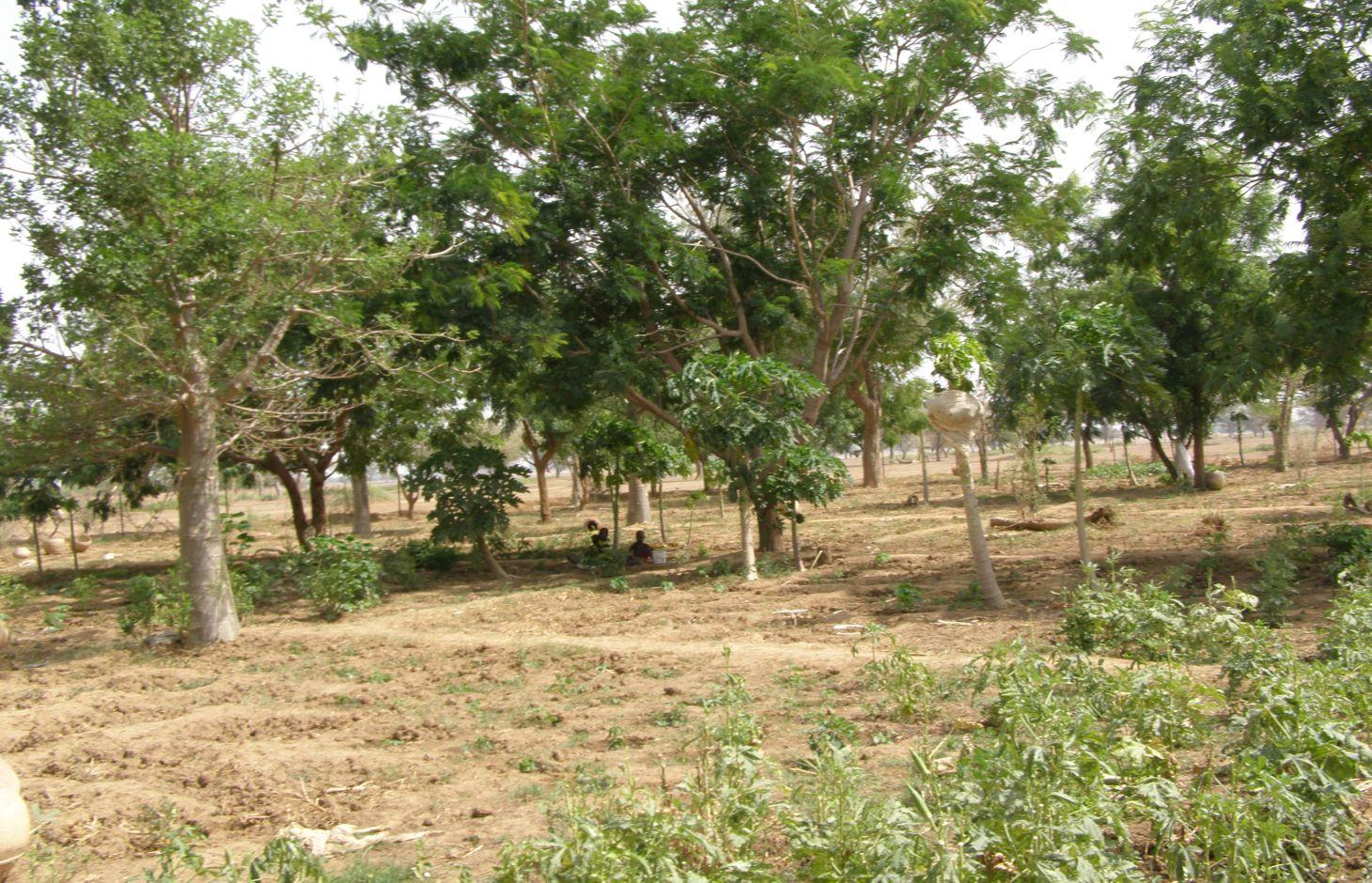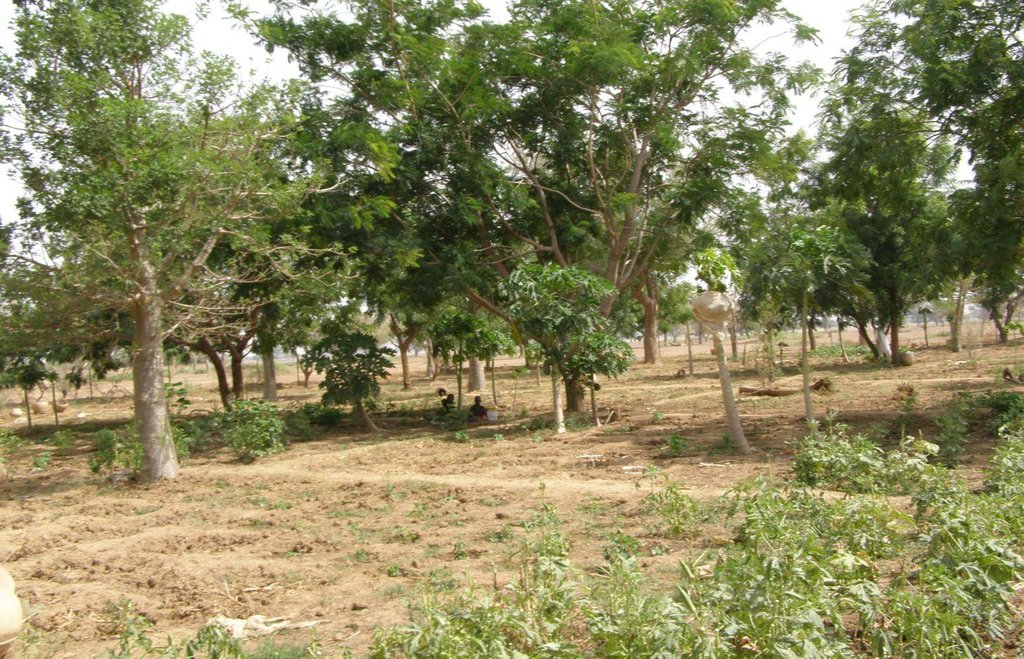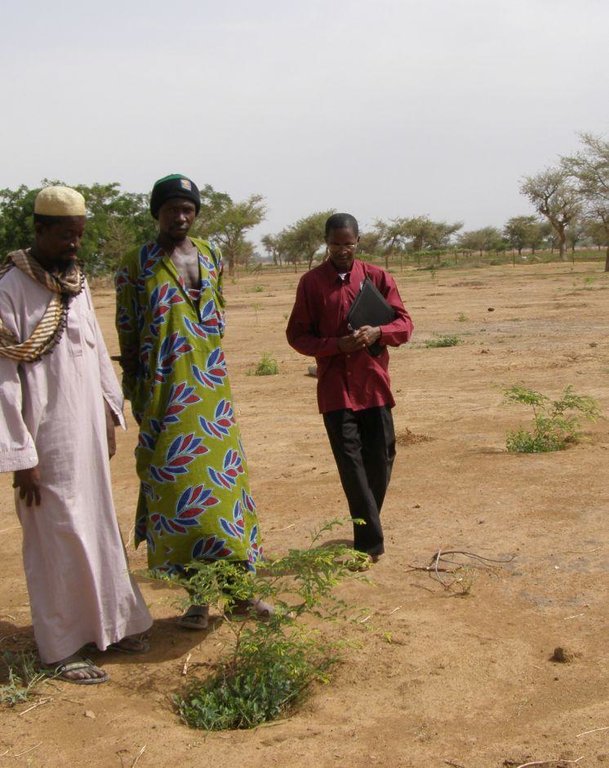Combining agroforestry and gardening to rehabilitate barren lands: the case of the Benkadi cooperative of Syn village [马里]
- 创建:
- 更新:
- 编制者: Dieter Nill
- 编辑者: –
- 审查者: Deborah Niggli, Alexandra Gavilano
Combinaison de l’agroforesterie et du maraichage pour réhabiliter des terres dénudées (French)
technologies_1638 - 马里
查看章节
全部展开 全部收起1. 一般信息
1.2 参与该技术评估和文件编制的资源人员和机构的联系方式
SLM专业人员:
Coulibaly Bakary Sékou
International Fund for Agricultural Development (IFAD)
马里
SLM专业人员:
Nadio Mamadou
National Coordinator for IFAD Programmes in Mali (CNPPF)
马里
有助于对技术进行记录/评估的项目名称(如相关)
Good Practices in Soil and Water Conservation - A contribution to adaptation and farmers ́ resilience towards climate change in the Sahel (GIZ)有助于对技术进行记录/评估的机构名称(如相关)
Deutsche Gesellschaft für Internationale Zusammenarbeit (GIZ) GmbH (GIZ) - 德国1.3 关于使用通过WOCAT记录的数据的条件
编制者和关键资源人员接受有关使用通过WOCAT记录数据的条件。:
是
1.4 所述技术的可持续性声明
这里所描述的技术在土地退化方面是否存在问题,导致无法被认为是一种可持续的土地管理技术?:
否
2. SLM技术的说明
2.1 技术简介
技术定义:
Through the installation of an irrigation scheme for market gardening combined with agroforesty, women’s production of trees and vegetables increases and infertile lands are restored.
2.2 技术的详细说明
说明:
An irrigation scheme for market gardening is installed on barren lands and agroforestry tree species are planted. The aim is to restore degraded lands by planting endemic trees like the baobab and néré, whose leaves and fruit are very commonly used for food and medicinal purposes.
The main objective of this activity is to improve women’s production of trees and vegetables, while ensuring infertile lands are restored. Market gardening also contributes to (i) raising farmers’ incomes through the production of peppers, okra and shallots, (ii) developing the shallot sector, and (iii) building farmers’ capacities.
The plot measures 100 by 100 metres. The planted and living species are: 60 baobab saplings (Adansonia digita), 120 papaya saplings (Carica papaya), 43 néré saplings (Parkia biglobosa), 26 lemon tree saplings (Citrus lemon), 2 tamarind tree saplings (Tamarindus indica), 21 grafted jujube saplings (Zizyphus sp). The vegetable beds are created in between the lines of trees. The vegetable growing site measures 105 by 100 metres (an area of 10,544 square metres). It is provided with farm equipment and machinery, including wells, distribution basins and wire fencing around the entire perimeter. It also contains: 9 Acacia albida saplings, 156 baobab saplings and 78 papaya saplings.
The vegetable growing season runs all year round and is divided into three crop productions. During the cold season from October to March, shallots are planted; in the hot season from March to June, okra is grown; and in the rainy season peppers are grown. Women work 100% of the site. There is a 90% adoption of the growing calendar. Okra and peppers benefit from fertiliser inputs and the techniques used for growing shallots.
Critical issues requiring attention are women’s poor access to the developed land and the scarcity of equipment, particularly for processing okra and shallots.
Located in the urban commune of Djenné, the ‘Benkadi’ cooperative was a beneficiary of SADeF funding in 2009/2010 (for its micro-project to develop a one-hectare market garden scheme). This cooperative was the product of the transformation of Syn women’s collective, which undertakes individual and collective activities, and focuses on the sustainable management of natural
resources. It was set up on 22 May 1998 and its headquarters are located in Syn. More than 130 women aged between 18 and 50 make up the cooperative, and nearly 30 cooperative members work the site. The main collective activities undertaken by the Syn-based ‘Benkadi’ cooperative company are: farming a biodiverse market garden plantation; operating a market garden; implementing a tontine (investment plan); fattening up livestock; growing ground nuts and tree growing; handicrafts. Concerns exist regarding enlarging and enhancing the site’s dewatering system to improve women’s accessibility to the developed land. Members are willing to provide at least 30 women to work the site each day.
SADeF’s installation of the market garden has enabled more than 100 women to take part in income-generating activities. The women have produced and traded: 20,069 kilograms of shallots per year; 150 x 100-kilogram sacks of peppers per year; 429 sacks of dry baobab leaves; 6,090 papaya fruits; 15,700 kilograms of okra. The output from the 2011 growing season made a profit of 12,242,620 CFA francs (23'690 Dollar).
2.3 技术照片
2.5 已应用该技术的、本评估所涵盖的国家/地区/地点
国家:
马里
区域/州/省:
Mali
2.6 实施日期
如果不知道确切的年份,请说明大概的日期:
- 不到10年前(最近)
2.7 技术介绍
详细说明该技术是如何引入的:
- 通过项目/外部干预
注释(项目类型等):
The ‘Benkadi’ cooperative was a beneficiary of SADeF funding in 2009/2010
3. SLM技术的分类
3.1 该技术的主要目的
- 改良生产
3.2 应用该技术的当前土地利用类型
同一土地单元内混合使用的土地::
是
具体说明混合土地使用(作物/放牧/树木):
- 农林业

农田
- 一年一作
- 多年一作(非木材)
- 乔木与灌木的种植
- okra, pepper
多年生(非木质)作物 - 指定作物:
- 药用、芳香、杀虫植物 - 多年生植物
乔木和灌木种植 - 指定作物:
- 木瓜
每年的生长季节数:
- 1
具体说明:
Longest growing period in days: 120; Longest growing period from month to month: August-November
注释:
Major land use problems (compiler’s opinion): degraded and bare land
Livestock density: 1-10 LU /km2
3.4 供水
该技术所应用土地的供水:
- 混合雨水灌溉
3.5 该技术所属的SLM组
- 森林种植管理
- 农业林学
3.6 包含该技术的可持续土地管理措施

植物措施
- V1:乔木和灌木覆盖层
注释:
Type of vegetative measures: scattered / dispersed
3.7 该技术强调的主要土地退化类型

土壤水蚀
- Wt:表土流失/地表侵蚀

化学性土壤退化
- Cn:肥力下降和有机质含量下降(非侵蚀所致)

生物性退化
- Bc:植被覆盖的减少
- Bs:质量和物种组成/多样性的下降
注释:
Main causes of degradation: crop management (annual, perennial, tree/shrub), droughts, population pressure
3.8 防止、减少或恢复土地退化
具体数量名该技术与土地退化有关的目标:
- 修复/恢复严重退化的土地
4. 技术规范、实施活动、投入和成本
4.1 该技术的技术图纸
技术规范(与技术图纸相关):
Technical knowledge required for field staff / advisors: high
Technical knowledge required for land users: low
Main technical functions: improvement of ground cover, increase in organic matter, increase of biomass (quantity), promotion of vegetation species and varieties (quality, eg palatable fodder), spatial arrangement and diversification of land use
Secondary technical functions: stabilisation of soil (eg by tree roots against land slides), increase / maintain water stored in soil, sediment retention / trapping, sediment harvesting, reduction in wind speed
Scattered / dispersed
Vegetative material: F : fruit trees / shrubs, C : perennial crops
Fruit trees / shrubs species: baobab, papaya, Acacia albida
Perennial crops species: shallots, okra, peppers
4.2 有关投入和成本计算的一般信息
其它/国家货币(具体说明):
CFA Franc
如相关,注明美元与当地货币的汇率(例如1美元=79.9巴西雷亚尔):1美元=:
517.0
4.3 技术建立活动
| 活动 | 时间(季度) | |
|---|---|---|
| 1. | vegetable beds are created in between the lines of trees, provided with farm equipment and machinery, including wells, distribution basins and wire fencing around the entire perimeter | |
| 2. | planting fruit trees and crops/vegetables |
4.4 技术建立所需要的费用和投入
| 对投入进行具体说明 | 单位 | 数量 | 单位成本 | 每项投入的总成本 | 土地使用者承担的成本% | |
|---|---|---|---|---|---|---|
| 其它 | Total construction | 1.0 | 35258.0 | 35258.0 | 100.0 | |
| 技术建立所需总成本 | 35258.0 | |||||
| 技术建立总成本,美元 | 68.2 | |||||
4.7 影响成本的最重要因素
描述影响成本的最决定性因素:
SADeF funded site works to the tune of 18,212,000 CFA francs (35'258 Dollar). The labour contributed by beneficiaries to the installation works is estimated to represent 5% of this, i.e. 910,600 CFA francs. The village authority ceded the site (around a hectare) for the plantation.
5. 自然和人文环境
5.1 气候
年降雨量
- < 250毫米
- 251-500毫米
- 501-750毫米
- 751-1,000毫米
- 1,001-1,500毫米
- 1,501-2,000毫米
- 2,001-3,000毫米
- 3,001-4,000毫米
- > 4,000毫米
农业气候带
- 半干旱
Thermal climate class: tropics
5.2 地形
平均坡度:
- 水平(0-2%)
- 缓降(3-5%)
- 平缓(6-10%)
- 滚坡(11-15%)
- 崎岖(16-30%)
- 陡峭(31-60%)
- 非常陡峭(>60%)
地形:
- 高原/平原
- 山脊
- 山坡
- 山地斜坡
- 麓坡
- 谷底
垂直分布带:
- 0-100 m a.s.l.
- 101-500 m a.s.l.
- 501-1,000 m a.s.l.
- 1,001-1,500 m a.s.l.
- 1,501-2,000 m a.s.l.
- 2,001-2,500 m a.s.l.
- 2,501-3,000 m a.s.l.
- 3,001-4,000 m a.s.l.
- > 4,000 m a.s.l.
5.3 土壤
平均土层深度:
- 非常浅(0-20厘米)
- 浅(21-50厘米)
- 中等深度(51-80厘米)
- 深(81-120厘米)
- 非常深(> 120厘米)
土壤质地(表土):
- 中粒(壤土、粉土)
- 细粒/重质(粘土)
表土有机质:
- 中(1-3%)
- 低(<1%)
5.4 水资源可用性和质量
地下水位表:
5-50米
地表水的可用性:
中等
水质(未处理):
仅供农业使用(灌溉)
5.5 生物多样性
物种多样性:
- 中等
5.6 应用该技术的土地使用者的特征
生产系统的市场定位:
- 混合(生计/商业)
非农收入:
- 收入的10-50%
相对财富水平:
- 贫瘠
- 平均水平
机械化水平:
- 手工作业
性别:
- 男人
说明土地使用者的其他有关特征:
Population density: < 10 persons/km2
Annual population growth: 2% - 3%
10% of the land users are rich.
50% of the land users are average wealthy.
30% of the land users are poor.
10% of the land users are very poor.
5.7 应用该技术的土地使用者使用的平均土地面积
- < 0.5 公顷
- 0.5-1 公顷
- 1-2 公顷
- 2-5公顷
- 5-15公顷
- 15-50公顷
- 50-100公顷
- 100-500公顷
- 500-1,000公顷
- 1,000-10,000公顷
- > 10,000公顷
这被认为是小规模、中规模还是大规模的(参照当地实际情况)?:
- 小规模的
5.8 土地所有权、土地使用权和水使用权
注释:
The irrigated land is allocated by the chief
5.9 进入服务和基础设施的通道
健康:
- 贫瘠
- 适度的
- 好
教育:
- 贫瘠
- 适度的
- 好
技术援助:
- 贫瘠
- 适度的
- 好
就业(例如非农):
- 贫瘠
- 适度的
- 好
市场:
- 贫瘠
- 适度的
- 好
能源:
- 贫瘠
- 适度的
- 好
道路和交通:
- 贫瘠
- 适度的
- 好
饮用水和卫生设施:
- 贫瘠
- 适度的
- 好
金融服务:
- 贫瘠
- 适度的
- 好
6. 影响和结论性说明
6.1 该技术的现场影响
社会经济效应
生产
作物生产
产品多样性
收入和成本
农业收入
收入来源的多样性
社会文化影响
食品安全/自给自足
冲突缓解
社会经济弱势群体的情况
Contribution to human well-being
注释/具体说明:
SADeF’s installation of the market garden has enabled more than 100 women to take part in income-generating activities. Infertile lands are restored and farmers’ incomes are raised through the production of peppers, okra and shallots.
生态影响
水循环/径流
地表径流
土壤
土壤水分
土壤覆盖层
土壤流失
土壤结壳/密封
养分循环/补给
土壤有机物/地下C
生物多样性:植被、动物
生物量/地上C
植物多样性
栖息地多样性
减少气候和灾害风险
风速
6.2 该技术的场外影响已经显现
下游洪水
下游淤积
风力搬运沉积物
6.3 技术对渐变气候以及与气候相关的极端情况/灾害的暴露和敏感性(土地使用者认为的极端情况/灾害)
渐变气候
渐变气候
| 季节 | 增加或减少 | 该技术是如何应对的? | |
|---|---|---|---|
| 年温度 | 增加 | 好 |
气候有关的极端情况(灾害)
气象灾害
| 该技术是如何应对的? | |
|---|---|
| 局地暴雨 | 好 |
| 局地风暴 | 好 |
气候灾害
| 该技术是如何应对的? | |
|---|---|
| 干旱 | 好 |
水文灾害
| 该技术是如何应对的? | |
|---|---|
| 比较和缓的(河道)洪水 | 好 |
其他气候相关的后果
其他气候相关的后果
| 该技术是如何应对的? | |
|---|---|
| 缩短生长期 | 好 |
6.4 成本效益分析
技术收益与技术建立成本相比如何(从土地使用者的角度看)?
短期回报:
积极
长期回报:
非常积极
技术收益与技术维护成本/经常性成本相比如何(从土地使用者的角度看)?
短期回报:
非常积极
长期回报:
非常积极
6.7 该技术的优点/长处/机会
| 编制者或其他关键资源人员认为的长处/优势/机会 |
|---|
| improves women’s production of trees and vegetables and restores degraded lands by planting endemic trees like the baobab and néré, whose leaves and fruit are very commonly used for food and medicinal purposes |
| Market gardening also contributes to raising farmers’ incomes through the production of peppers, okra and shallots; developing the shallot sector; and building farmers’ capacities |
| SADeF’s installation of the market garden has enabled more than 100 women to take part in income-generating activities |
6.8 技术的弱点/缺点/风险及其克服方法
| 编制者或其他关键资源人员认为的弱点/缺点/风险 | 如何克服它们? |
|---|---|
| Critical issues requiring attention are women’s poor access to the developed land and the scarcity of equipment, particularly for processing okra and shallots. |
7. 参考和链接
7.1 信息的方法/来源
- 实地考察、实地调查
- 与土地使用者的访谈
(现场)数据是什么时候汇编的?:
01/07/2012
7.2 参考可用出版物
标题、作者、年份、ISBN:
Manual of Good Practices in Small Scale Irrigation in the Sahel. Experiences from Mali. Published by GIZ in 2014.
可以从哪里获得?成本如何?
http://star-www.giz.de/starweb/giz/pub/servlet.starweb
标题、作者、年份、ISBN:
Plan d’affaires du micro-projet de maraîchage de la Société Coopérative “Benkadi” de Syn [Business plan for the market gardening micro-project of the ‘Benkadi’ Cooperative Company in Syn], Djenné Commune, GADC, July 2011
链接和模块
全部展开 全部收起链接
无链接
模块
无模块






